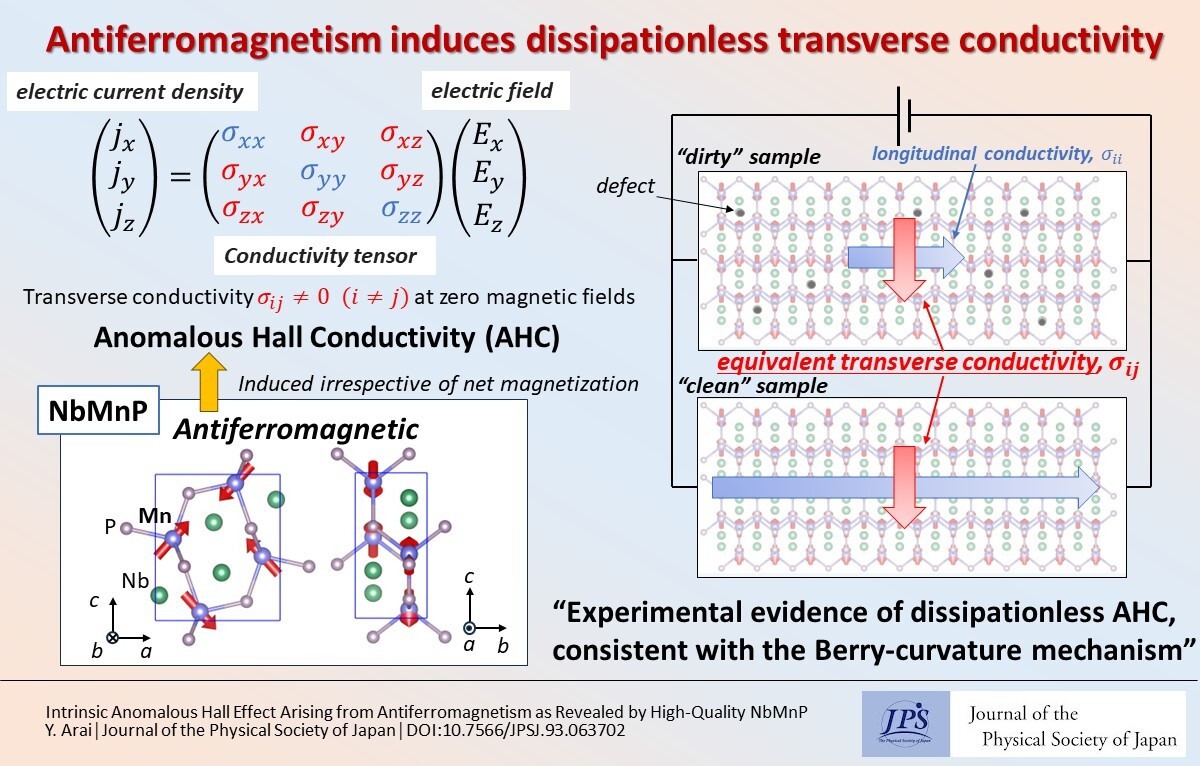Antiferromagnetism Induces Dissipationless Transverse Conductivity
© The Physical Society of Japan
This article is on
Intrinsic Anomalous Hall Effect Arising from Antiferromagnetic as Revealed by High-Quality NbMnP
(JPSJ Editors' Choice)
J. Phys. Soc. Jpn.
93,
063702
(2024)
.
An investigation using high-quality NbMnP crystals demonstrates that the anomalous Hall conductivity arising from antiferromagnetism is dissipationless, as expected from the intrinsic mechanism.

The anomalous Hall effect (AHE) is the Hall effect that emerges at zero magnetic fields. It was discovered in ferromagnets more than 100 years ago; however, its mechanism had long been controversial. In the 2000s, the band-structure effect, known as the intrinsic mechanism, was reconstructed based on the Berry phase concept. Many theoretical and experimental investigations revealed that the intrinsic mechanism contributes significantly to the AHE in ferromagnets. This is experimentally confirmed by observing the scattering dependence of the anomalous Hall conductivity (AHC), i.e., the transverse conductivity, because the intrinsic mechanism contributes to a dissipationless AHC, which is independent of scattering.
Meanwhile, the Berry phase concept clarifies that the AHE is not triggered by magnetization but by symmetry breaking. This resulted in the discovery of the prominent AHEs in antiferromagnetic (AF) materials. Several AF materials exhibiting the AHE have been discovered; however, a system that can offer high-quality crystals has not been discovered. The scattering dependence of the AHC arising from AF structures must be investigated.
In this study, high-quality crystals with large AHE arising from the AF structure were obtained in NbMnP using the Ga-flux method. Using high-quality NbMnP, we investigated the scattering dependence of the AHC against a wide range of electrical conductivities. Consequently, dissipationless AHC was experimentally confirmed for the AF material.
The prospective benefits of obtaining high-quality NbMnP are not limited to understanding the AHE. This AF material is expected to generate other ferromagnetic responses, such as the anomalous Nernst effect (ANE). Influence of disorder on the ANE has not been investigated comprehensively, including that for ferromagnets; thus, their impurity dependence must be elucidated. NbMnP is a suitable material for assessing the effect of impurities on ferromagnetic responses under the AF spin configuration.
(Written by Y. Arai on behalf of all authors.)
Intrinsic Anomalous Hall Effect Arising from Antiferromagnetic as Revealed by High-Quality NbMnP
(JPSJ Editors' Choice)
J. Phys. Soc. Jpn.
93,
063702
(2024)
.
Share this topic
Fields
Related Articles
-
Higher-Order Topological Phases in Magnetic Materials with Breathing Pyrochlore Structures
Electronic structure and electrical properties of surfaces and nanostructures
Magnetic properties in condensed matter
Mathematical methods, classical and quantum physics, relativity, gravitation, numerical simulation, computational modeling
2025-4-7
A simple example of a higher-order topological phase, in which the symmetry decreases step-by-step from the bulk to the corner, is realized in a magnetic system with a pyrochlore structure and is characterized by a series of quantized Berry phases defined for the bulk, surface, and edge.
-
Existence of Chiral Soliton Lattices (CSLs) in Chiral Helimagnet Yb(Ni1-xCux)3Al9
Magnetic properties in condensed matter
2025-4-1
Our study examines the magnetic structure of the monoaxial chiral helimagnet Yb(Ni1-xCux)3Al9, providing first direct evidence of the formation of chiral soliton lattice state.
-
Understanding Pressure-Induced Superconductivity in CrAs and MnP
Magnetic properties in condensed matter
2025-3-10
This study reviews existing research on the pressure-induced variation of magnetic properties of transition metal mono-pnictides like CrAS, MnP, and others, aiming to understand the unconventional superconductivity observed in CrAs and MnP.
-
A Unified Theory of Topological Hall Effect
Electronic transport in condensed matter
2025-3-6
This paper presents a unified theoretical description for the topological Hall effect, covering the entire region from strong- to weak-coupling, extending its picture beyond the Berry phase.
-
Excitonic Insulators: Challenges in Realizing a Theoretically Predicted State of Matter
Electron states in condensed matter
Electronic transport in condensed matter
2025-3-3
The realization of an excitonic insulator can help in the establishment of a new electronic state in condensed matter physics, one that has the potential to exhibit novel electric, magnetic, and optical responses beyond those of conventional materials.




